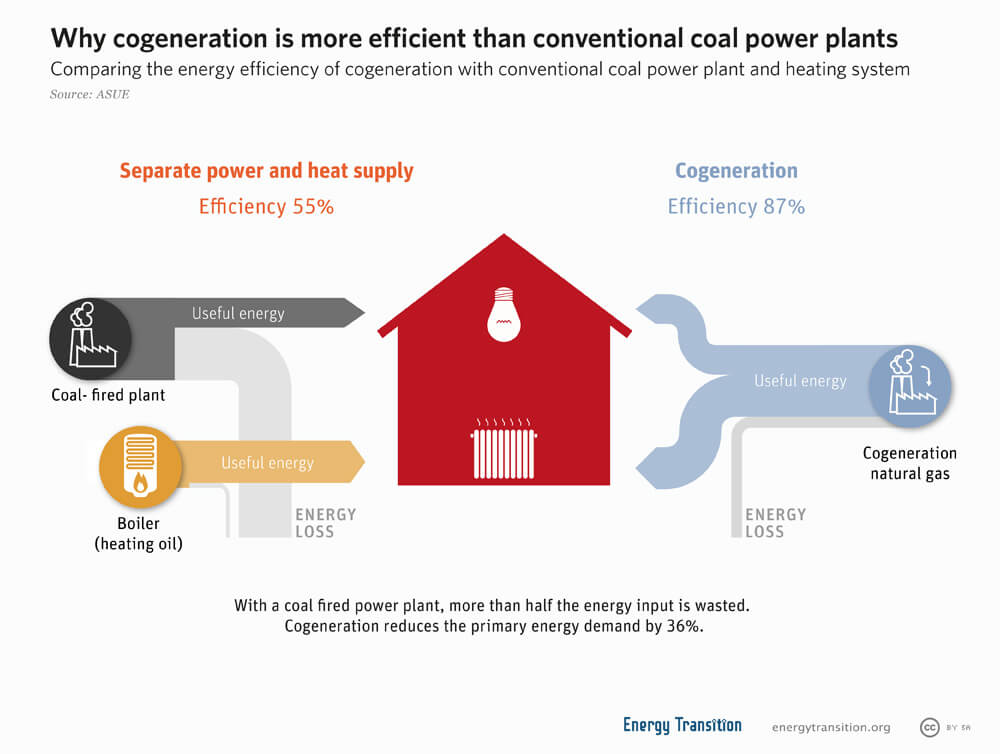WHAT IS COGENERATION?
Energy consumption continues to be a big concern for businesses & consumers alike. When it comes to Energy Wastage, industrial plants are the guiltiest of them all. The majority of plants that use Fossil Fuels to produce Electricity end up releasing an excess amount of Heat into the atmosphere – aka wasted byproduct. Imagine plants capturing this Heat energy & reusing it to produce additional power.
Well, this is exactly what’s done with Cogeneration technology. In a nutshell, Cogeneration is when two types of Energy are produced in one industrial plant. In many cases, a plant may produce Electricity & Steam or Hot Water. In this instance, the plant can use the Hot Water or Steam so Energy isn’t lost during transport.
What are the benefits of Cogeneration?
Let’s look a little deeper at the various benefits of Cogeneration. All consumer types can witness the following benefits:
• Better energy conservation, efficiency & use. In fact, it’s the most effective & efficient form of power generation.
• Reduced CO2 emissions, which is the main greenhouse gas causing global warming.
• Major cost savings, adding competitiveness for commercial & industrial users. Also makes it more affordable for domestic users to obtain heat.
• Decentralization of electricity generation, where plants focus on the needs of local customers.
• Enhanced local & general security of supply. Minimizes the risk of consumers being without heat &/or electricity.
• Import dependency reduces, since there’s less need for fuel.
• More jobs created, which in turn boosts the economy.
Why you should use Cogeneration
Cogeneration sounds good on paper, but is it something you should implement into your own facility? In general, wherever a large amount of Heating or Cooling is consumed, there’s an opportunity to benefit from Cogeneration.
If you have consistent Thermal & Electric Loads, such as you’ll find in Hospitals, Industrial Facilities, Hotels, Schools & Nursing Homes, then Cogeneration may be a good idea.
It all comes down to certain factors. If you meet the following criteria, then you should consider Cogeneration:
• You have an Energy Demand that’s All-Year-Round
• You have an extended 24-Hour Energy Demand
• You don’t have Tax Credits or other funds you can take advantage of
• Your facility produces Landfill Gas, Methane Gas or Biofuels
• You’re ready to replace your Heating & Cooling Systems
It’s also key to review the costs of your Energy Consumption & whether you have sustainability & Energy Efficiency goals you want to achieve.
Interesting Facts about Cogeneration & Energy Efficiency
One of the reasons Commercial & Industrial businesses are looking to Cogeneration is because of the Energy Efficiency it provides. In fact, the conservation of Energy is anywhere between 30% & 90%. Plus, it minimizes the release of Carbon Emissions. This equates to about 15 to 40% in Energy Savings. Rather than using twice the Fossil Fuels to double Energy production, Cogeneration uses two forms of Energy to create one Power Source. So it’s a Two-for-One deal.
It’s easier to use Cogeneration when Power Plants are closer to the buildings it’s supplying Electricity & Heating to. Unfortunately, urbanization & suburban developments have made Cogeneration nearly impossible. Over the past 50 years, communities have moved further away from Power Suppliers. Most families & businesses find the idea of being next to Power Plants unappealing.
Supplying faraway communities with Heat & Steam Cogenerated with Electricity just isn’t plausible today. The longer transport makes it more expensive, plus there’s the risk of Energy loss. But there’s hope yet – Power Plants that are implementing Cogeneration into their process are a lot safer, cleaner & better for the environment compared to before. The benefits outweigh the cons of moving plants closer to urban communities.





























